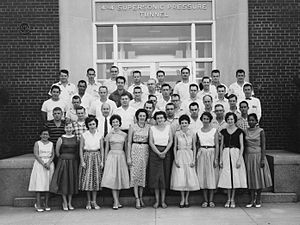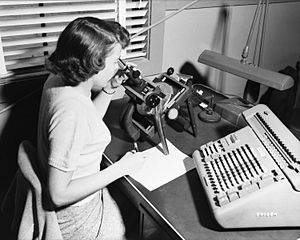Computer (occupation) facts for kids
Before electronic computers existed, a "computer" was a person who did math calculations. This term has been used since the early 1600s. A famous scientist, Alan Turing, said a human computer had to follow exact rules. They couldn't change anything. Often, groups of people worked together on long and boring calculations. They would split the work to do it faster. Sometimes, different teams did the same calculations. This helped them check if the answers were correct.
Since the late 1900s, "human computer" also describes people who are amazing at doing math in their heads. These people are also called mental calculators.
Contents
Early Human Computers in Science
Astronomers and Their Helpers
In the Renaissance period, Astronomers often called themselves "mathematicians." Their main job was to calculate the positions of planets. They often hired a "computer" to help them. For some, like Johannes Kepler, this was a temporary job. They would later move on to bigger scientific roles.
Computing became more organized in France. Alexis Claude Clairaut (1713–1765) divided a big calculation. He wanted to figure out when Halley's Comet would return. He shared this work with two friends, Joseph Lalande and Nicole-Reine Lepaute. Human computers kept working to predict where planets would be. They created special tables for almanacs in the late 1760s.
Working on Nautical Almanacs
In Britain, human computers worked on The Nautical Almanac. This book helped sailors navigate at sea. William Wales, Israel Lyons, and Richard Dunthorne were some of these computers. Nevil Maskelyne was in charge of the project. He tried to use existing tables to reduce the work for his team.
Most women were not allowed to be computers back then. But there were some exceptions. Mary Edwards worked from the 1780s to 1815. She was one of 35 computers for the British Nautical Almanac. The United States also made its own nautical almanac in the 1840s. Maria Mitchell was one of the most famous computers on their team.
Organizing the Work
Other new ideas in human computing came from George Biddell Airy. He was the Astronomer Royal at the Royal Observatory, Greenwich. He hired a group of boys to work in the Octagon Room after 1835. Some of these boys were as young as fifteen. They worked on a lot of old astronomical data. Airy set up the Octagon Room very well. He had a manager, special forms, and standard ways to calculate and check results. This method became a standard for computing for the next 80 years.
After 1865, more and more women became involved in computing. Private companies hired them to do calculations and manage office staff.
Tracking Weather and Stars
In the 1870s, the United States Signal Corps found a new way to organize human computing. They used it to track weather patterns. This built on earlier work from the US Navy. The Signal Corps had a small team of computers. They processed data very quickly in "intensive two-hour shifts." Each person was only responsible for a small part of the data.
In the late 1800s, Edward Charles Pickering organized the "Harvard Computers." The first woman to ask for a computing job there was Anna Winlock in 1875. By 1880, all the computers at the Harvard Observatory were women. They usually earned twenty-five cents an hour. Many women wanted to work there so much that some even offered to work for free! Many famous women astronomers from this time were computers. These included Florence Cushman, Henrietta Swan Leavitt, and Annie Jump Cannon. Cannon could classify stars incredibly fast, about three per minute. Mina Fleming, another Harvard Computer, published a big star catalog in 1890. It organized stars by their spectral lines. The Harvard Computers kept adding new stars to this catalog. Elizabeth Williams helped calculate where to look for a new planet, which turned out to be Pluto.
Statistical Research
In 1893, Francis Galton created a committee to study plants and animals. This committee used advanced methods for scientific research. It supported the work of several scientists. W.F. Raphael Weldon was the first scientist supported by the committee. His wife, Florence Tebb Weldon, was his computer. Weldon used logarithms and math tables. He did not have a calculating machine.
Karl Pearson had a lab at the University of London. He created a math formula that the committee used for data. Pearson brought his formula to his own Biometrics Laboratory. He had both paid and volunteer computers, including men and women. Alice Lee was one of his paid computers. She worked with histograms and chi-squared statistics. Pearson also worked with Beatrice and Frances Cave-Brown-Cave. By 1906, Pearson's lab was very good at making mathematical tables.
Making Math Tables
Human computers were very important for creating math tables in the 1700s and 1800s. These included tables for trigonometry and logarithms. Even though these tables were often named after a main mathematician, many unknown computers did the actual work. More and more accurate tables were needed for navigation and engineering.
One way they worked was by breaking down the project into smaller tasks. People would complete these tasks at home. These computers were often educated middle-class women. Society often thought it was not proper for them to work outside the home. They would receive and send back packets of calculations by mail. In 1925, the Royal Astronomical Society created a new group, the Mathematical Tables Committee. This was the only professional organization for human computers at the time.
Fluid Dynamics and Weather Prediction
Human computers helped predict what would happen when the Afsluitdijk was built. This was a large dam constructed between 1927 and 1932 in the Zuiderzee in the Netherlands. Hendrik Lorentz set up this computer simulation.
Lewis Fry Richardson had a big idea for weather forecasting. In 1922, he thought that 64,000 humans could predict the weather for the whole world. They would do this by solving complex math problems. Around 1910, he had already used human computers. They calculated the pressure inside a stone dam.

Wartime Computing and Early Electronics
World Wars and Women Computers
Computing became a real profession during World War I. Both sides of the war needed many human computers. They created map grids, navigation tables, and artillery tables. Since many men were fighting, most of these new computers were women. Many of them had college degrees. This happened again during World War II. As more men joined the war, college-educated women filled their jobs.
One of the first female computers, Elizabeth Webb Wilson, was hired by the Army in 1918. She had a degree from George Washington University. Wilson wanted a war job that used her math skills. She later said the war saved her from just going to social events. Instead, she was able to have a career. After the war, Wilson continued her math career and became an actuary. She focused on life tables.
Human computers were very important during World War II in the United States. Because many men were drafted into the military, many computers during World War II were women. Often, they had degrees in mathematics. In the 1940s, women were hired to study nuclear particles. In the Manhattan Project, human computers used different machines. They helped with math studies for complex formulas about nuclear fission.
From Calculators to Programmers
Human computers helped calculate tables for artillery during World War I. Between the two world wars, computers worked at the Department of Agriculture and Iowa State College. These human computers also used calculating machines and early electrical computers. In the 1930s, the Columbia University Statistical Bureau was created. Organized computing also started at Indiana University and other research groups.
After World War II, the National Advisory Committee for Aeronautics (NACA) used human computers. They would copy raw data from film and oscillograph paper. Then, using slide rules and electric calculators, they turned the data into standard engineering numbers.
The book Hidden Figures (which became a movie) tells the story of African American women. They worked as human computers at NASA. They helped with the Friendship 7 mission. This was the first time an American went into Earth orbit. NACA started hiring black women as computers in 1940. One of them was Dorothy Vaughan. She started working in 1943 at the Langley Research Center. She was hired to help with the war effort. She later supervised the West Area Computers. This was a group of African-American women who worked as computers at Langley. At that time, human computing was often seen as low-level work. On November 8, 2019, these women received the Congressional Gold Medal. This honored all the women who worked as computers, mathematicians, and engineers at NACA and NASA from the 1930s to the 1970s.
As electrical computers became more common, human computers became some of the first computer programmers. The first six people who set up problems on the ENIAC were women. The ENIAC was the first general-purpose electronic digital computer. These women were Kay McNulty, Betty Snyder, Marlyn Wescoff, Ruth Lichterman, Betty Jean Jennings, and Fran Bilas. They were the world's first professional computer programmers.
Human-Assisted Computation Today
Today, the term "human computer" is sometimes used by researchers. They call their work "human computation." In this case, "human computer" means when humans help with tasks that a machine can't easily do. This is part of something called human-based computation (HBC).
This modern use of "human computer" is a bit different. In HBC, a machine gives parts of a task to humans. These tasks don't always have exact steps to follow. Humans might solve the problem in their own way. So, using humans in the old "human computer" role for HBC is quite rare.
See also
 In Spanish: Calculadora humana para niños
In Spanish: Calculadora humana para niños



